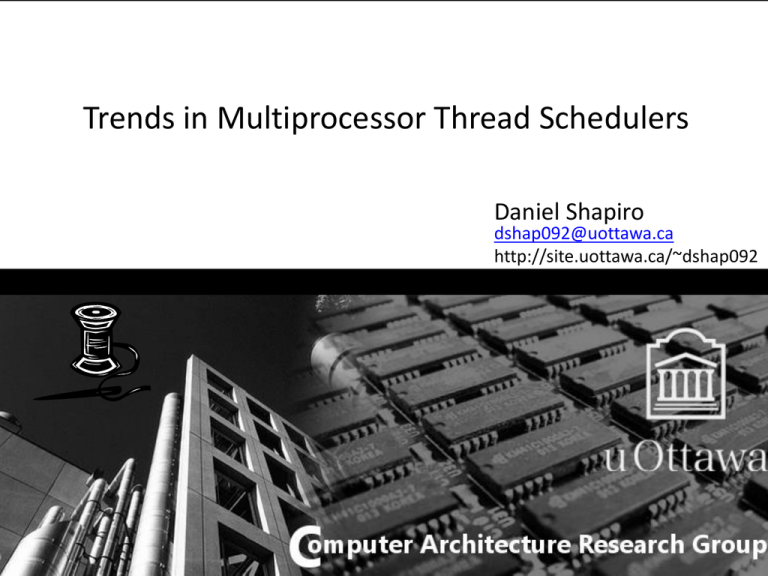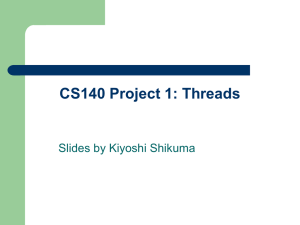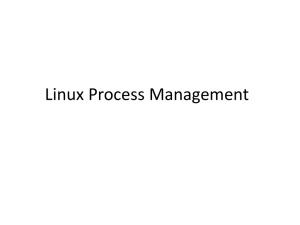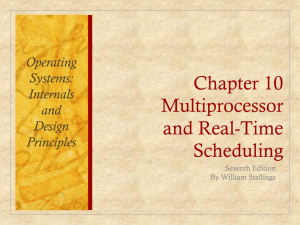Trends in Multiprocessor Thread Schedulers
advertisement

Trends in Multiprocessor Thread Schedulers Daniel Shapiro dshap092@uottawa.ca http://site.uottawa.ca/~dshap092 Thread Scheduler • Multithreading • Thread scheduler – Quickly choose among the list of ready-to-run threads to execute a subset of them on the available hardware – Maintain the ready-to-run and stalled thread lists. – Different thread priority schemes can be used by the scheduler. – The thread scheduler can be implemented in software, hardware or a mix. Overview • • • • • • • Problems Papers Progress Clustering Performance metrics Metrics analysis Performance Gains (not completed) MP Thread Scheduling Problems 1. OS jitter 2. Scheduling algorithm selection 3. Priority assignment 4. Priority inversion 5. Thread competition 6. Dynamic scheduling and resource utilization 7. Inter-processor communication 8. Interrupts: Low priority interrupts halt high priority threads 1. Intermittent slowdown in thread due to hidden OS activity 2. Many possible algorithms 3. Threads do not have HW priorities 4. Medium priorities starve high priority threads 5. Deadlocks and livelocks 6. Hard to assign threads to maximize HW utilization 7. Dependencies tend to ruin the available parallelism Paper Titles “Predictable performance in SMT processors: synergy between the OS and SMTs” “Preemption threshold scheduling: Stack optimality, enhancements and analysis” PTS tries ad-hoc to minimize preemptions as much as possible while preserving the system’s schedulability. “Performance effect of localized thread schedules in heterogeneous multi-core processors” “On better performance from scheduling threads according to resource demands in MMMP” Multi-core Multi-threading Microprocessor balance CPI_mem “Parallelism-aware batch scheduling: Enabling high-performance and fair shared memory controllers” “Preemptive virtual clock: A flexible, efficient, and cost-effective QoS scheme for networks-on-chip” priority inversion, buffering, trade-off between the strength of the guarantees and throughput, bandwidth provision per thread. “Thread priority sensitive simultaneous multi-threading fair scheduling strategy” “Improving priority enforcement via non-work-conserving scheduling” co-runners “A dual-priority real-time multiprocessor system on fpga for automotive applications” Paper Titles “Prioritized SMT architecture with IPC control method for real-time processing” throughput vs priority “Handling OS jitter on multicore multithreaded systems” “Improving performance isolation on chip multiprocessors via an operating system scheduler” co-runners “Limos: A lightweight multi-threading operating system dedicated to wireless sensor networks” 2-level sched preempt/not, event driven “Reservationbased interrupt scheduling” trade-off between predictability and hardware performance “Real-time java and multi-core architectures” “Predictable interrupt management and scheduling in the composite componentbased system” security dependable and predictable for untrusted user code “Sloth: Threads as interrupts” Areas of Progress Well-Known Scheduling Problems • Handling OS Jitter • Preemption threshold scheduling (PTS) is the optimal real-time algorithm for reducing stack memory size. • Parallelism-aware batch scheduling • QOS Scheme prevents priority inversion • Synergy between the OS and SMTs And Thread Performance • Performance Effect of Localized Thread Schedules • Thread Performance Isolation using Operating System Scheduler • Thread priorities during instruction scheduling in SMT • Priority enforcement via nonwork-conserving scheduling • Prioritized SMT Architecture with Inter-processor communication (IPC) Control Method • Scheduling Threads According to Resource Demands Areas of Progress Applications • A Dual-Priority MPSoC for cars • Multi-threading OS for WSN • Real-Time Java and MultiCore Architectures And Interrupt Ideas • Threads as Interrupts • Reservation-Based Interrupt Scheduling • Predictable Interrupt Scheduling Clustering of Topics Scheduling to improve thread performance [1, 2, 3, 4, 15, 5] Relationship between interrupts and threads [16, 14, 17] Scheduling Multiprocessor Threads OS impact on thread performance [11, 12, 13] Thread priority schemes [6, 7, 8, 9, 10, 15] Performance Metrics Resource Utilization Analysis • In [2, 9,10, 13], the units for resource utilization were memory bytes[2, 13], shared PE hardware [9], and the common instruction buffer [10]. • The resource utilization is not necessarily a good metric for performance. • One can imagine that keeping hardware units busy or memory usage low does not necessarily translate into a higher throughput of threads or a bigger speedup. Throughput Analysis • In [1, 4, 5, 6, 8, 10, 12], throughput is discussed in terms of the balance between instructions issued and fairness to priority. • IPC control: balancing priority and throughput. • Clearly, throughput maximization in a system with multiple threads is nominally good, but as with IPC, this number does not represent a full picture of the system performance. Speedup Analysis • [12] used slowdown as a measure of performance, but then also had negative slowdown to represent speedup. Speedup was used as a metric in [5, 7, 8, 12, 11]. • This metric is very commonly in computer architecture papers for expressing the benefit of an approach. • Speedup may abstract the finer grained details of a multiple thread program, where situations such as priority inversion and thread starvation are often more important than the overall system speedup. Exec Time Analysis • [2, 3, 5, 6, 9, 10, 11, 12] used seconds, microseconds, abstract units in a simulation (called time, latency), and cycles as units for execution time. • While cycles and ticks in a simulation remove the clock frequency from consideration, real time units provide a much better understanding of the real-world implications of a given approach. IPC Analysis • [12, 7] normalized the collected samples, while [4] gave an average IPC, and [7, 10] presented raw IPC values. • Maximizing IPC does not guarantee better throughput, as we have seen in the RISC versus CISC comparison. – Specifically, RISC has a simpler instruction set and so even though the Cycles Per Instruction (CPI) is minimized compared to the CISC, the CISC can perform a broader range of operations, and can directly access the global memory in a single cycle. • Having said this caveat, IPC is probably interesting for thread analysis because it gives an idea of the number of events happening in parallel. Caches Analysis • Cache miss rates: the number of misses was observed by [4] and the miss rate was observed by [12]. • Scheduling is so sensitive to cache coherence policy, size, and structure that it should probably be reported on more often. • Sometimes there is not enough data available on the inner workings of the cache at runtime, and so a simulator or hardware debug support is required. • In some cases there is no cache or limited caching present in the hardware, such as the multiprocessor MicroBlaze system in [9] where there is a local memory for data and an L1 instruction cache. Response Time Analysis • Response time and/or the jitter in response time was noted by [6, 9, 11, 12] • Was represented as a percentage of total execution time [11], and time spent waiting. • Jitter is typically random a runtime effect, and so static scheduling will not be able to take such noise into account easily. Benchmark Analysis • The benchmark used to obtain the stated metrics were: – – – – – – – – – – • • • IDCT in [10] MiBench in [9, 7] SPEC CPU2000 in [1, 12,7, 4] SPEC CPU2006 for [8] Trace Collector in [11] PapaBench in [2] PARSEC in [6] netperf in [14] PCMark05 in the related work of [3] In [16] the programs referred to as ”microbenchmarks” were non-standard. It is proposed in [15] that a new benchmark suite is needed for real-time Java on parallel processors. This will only continue the trend (e.g. ISE identification) that one can see in performance evaluation where the benchmarks used are not the same even for a small cluster of papers in a subspecialty of computer architecture. It is worth noting that SPEC CPU and MiBench are broadly used. Performance Gains • Not done yet • +taxonomy • qualitative References [1] F.J. Cazorla, P.M.W. Knijnenburg, R. Sakellariou, E. Fernandez, A. Ramirez, and M. Valero, “Predictable performance in smt processors: synergy between the os and smts,” Computers, IEEE Transactions on, vol. 55, no. 7, pp. 785 – 799, 2006. [2] R. Ghattas and A.C. Dean, “Preemption threshold scheduling: Stack optimality, enhancements and analysis,” in Real Time and Embedded Technology and Applications Symposium, 2007. RTAS ’07. 13th IEEE, 2007, pp. 147 –157. [3] F.N. Sibai, “Performance effect of localized thread schedules in heterogeneous multi-core processors,” in Innovations in Information Technology, 2007. IIT ’07. 4th International Conference on, 2007, pp. 292 –296. [4] Lichen Weng and Chen Liu, “On better performance from scheduling threads according to resource demands in mmmp,” in Parallel Processing Workshops (ICPPW), 2010 39th International Conference on, 2010, pp. 339 –345. [5] O. Mutlu and T. Moscibroda, “Parallelism-aware batch scheduling: Enabling high-performance and fair shared memory controllers,” Micro, IEEE, vol. 29, no. 1, pp.22 –32, 2009. [6] B. Grot, S.W. Keckler, and O. Mutlu, “Preemptive virtual clock: A flexible, efficient, and cost-effective qos scheme for networks-onchip,” in Microarchitecture, 2009. MICRO-42. 42nd Annual IEEE/ACM International Symposium on, 2009, pp. 268 –279. [7] Cheng Lian and Yang Quansheng, “Thread priority sensitive simultaneous multi-threading fair scheduling strategy,” in Computational Intelligence and Software Engineering, 2009. CiSE 2009. International Conference on, 2009, pp. 1 –4. [8] J.C. Saez, J.I. Gomez, and M. Prieto, “Improving priority enforcement via non-work-conserving scheduling,”in Parallel Processing, 2008. ICPP ’08. 37th International Conference on, 2008, pp. 99 –106. [9] A. Tumeo, M. Branca, L. Camerini, M. Ceriani, M. Monchiero, G. Palermo, F. Ferrandi, and D. Sciuto,“A dual-priority real-time multiprocessor system on fpga for automotive applications,” in Design, Automation and Test in Europe, 2008.DATE ’08, 2008, pp. 1039–1044. [10] N. Yamasaki, I. Magaki, and T. Itou, “Prioritized SMT architecture with ipc control method for real-time processing,” in Real Time and Embedded Technology and Applications Symposium, 2007. RTAS ’07. 13th IEEE, 2007, pp. 12 –21. [11] P. De, V. Mann, and U. Mittaly, “Handling os jitter on multicore multithreaded systems,” in Parallel Distributed Processing, 2009. IPDPS 2009. IEEE International Symposium on, May 2009, pp. 1 –12. [12] A. Fedorova and M. Seltzer, “Improving performance isolation on chip multiprocessors via an operating system scheduler,” in Parallel Architecture and Compilation Techniques, 2007. PACT 2007. 16th International Conference on, 2007, pp. 25 –38. [13] Hai ying Zhou and Kun mean Hou, “Limos: A lightweight multi-threading operating system dedicated to wireless sensor networks,” in Wireless Communications, Networking andMobile Computing, 2007.WiCom 2007. International Conference on, 2007, pp. 3051 –3054. [14] N. Manica, L. Abeni, and L. Palopoli, “Reservationbased interrupt scheduling,” in Real-Time and Embedded Technology and Applications Symposium (RTAS), 2010 16th IEEE, 2010, pp. 46 –55. [15] V. Olaru, A. Hangan, G. Sebestyen-Pal, and G. Saplacan,“Real-time java and multi-core architectures,” in Intelligent Computer Communication and Processing, 2008. ICCP 2008. 4th International Conference on, 2008, pp. 215 –222. [16] G. Parmer and R. West, “Predictable interrupt management and scheduling in the composite component-based system,” in Real-Time Systems Symposium, 2008, dec. 2008, pp. 232 –243. [17] W. Hofer, D. Lohmann, F. Scheler, and W. Schroder- Preikschat, “Sloth: Threads as interrupts,” in Real-Time Systems Symposium, 2009, RTSS 2009. 30th IEEE,2009, pp. 204 –213. Questions? SCRIBING, AND ANSWERING TO THE QUESTIONS • Report (total 3 weeks after the lecture): – Scribing of the lecture – Questions and paper analysis need to be answered • New questions/problems need to be defined and solved (5 problems (programming, algorithm, computer architecture design) and 5 questions) • Review (1 week) • Final submission (1 week) • The goal of this exercise is: – – – – To do review To prepare slides with the comments To prepare questions for the others To answer to the reviewer comments SCRIBING, AND ANSWERING TO THE QUESTIONS • • • • • • • • • • • • • • • • • Scribing Is the lecture correctly covered? If not, please provide recommendations. Are the references correct? Are they up-to-date? Are they in correct format? Is every figure properly referenced? Is there any copy-paste? Answering to the questions Are all the questions answered properly Did the student consult the appropriate literature? If not, please recommend more references. Did the student perform proper comparison? Proposed questions and their solutions Do the questions and problems make sense? Are they too easy? If yes, then suggest some other. Did the student answered correctly? Style and format Are the paper and references in IEEE format? Please correct English The technical report will be marked based upon the advice in the document "The best method for presentation of research results in theses and papers" by Prof. Ivan Stojmenovic. http://www.site.uottawa.ca/~dshap092/ceg4136/Stojmenovic.pdf








